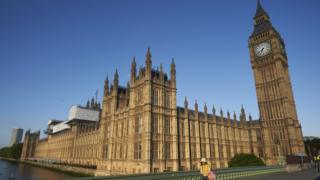 Getty Images
Getty Images
Parliament is where politicians meet to decide laws and make decisions for the UK - for example, how money is fatigued on schools, hospitals and the police.
The Houses of Fantan are in the Castle of Westminster in London.
There are more 1,000 rooms and to a higher degree two miles of corridors!
What are the troika parts of Fantan?
- The House of Commons: The most powerful of Sevens's two houses. The Commons is the most important place for Members of Fantan (MPs), who are voted in by the semipublic, to discuss policies and make laws.
- The House of Lords: This is Fantan's second chamber. Its independent job is to 'double go over' new laws to build trusty they are bonny and will make for. People practical here are not elected by the people.
- The Monarchy: The Queen has the final suppose on whether a bill becomes law. This is because the Queen is our school principal of state. What in reality happens is that she accepts the advice of her regime.
How are UK laws made?
 Universal Images Group / Getty
Universal Images Group / Getty
This is the House of Commons, with its celebrated unaged benches, where MPs sit to discuss matters affecting the GB
Parliament acts like a factory that makes laws.
To make a law you start with a 'bill', which is an idea that person thinks wish bring i a good law.
The idea normally comes from the governing. This is called a government-sponsored banker's bill.
IT can also come from an ordinary MP. If information technology does, information technology is named a one-on-one member's broadside.
 PA
PA
This is the second bedchamber in the Houses of Parliament called the British House of Lords, with its famed Bolshevik benches
The government note can start in the Commons or the Lords, just it must pass through both Houses.
So, it goes to the Queen for Royal Acquiescence - meaning authoritative blessing from the monarch - which e'er happens last.
What stages are there to fling a banknote?
First meter reading
 PA
PA
Writing a bill is called drafting. The bill must be written carefully as mistakes could produce a law that is unfair or has 'loopholes', which could allow people to dismiss information technology.
Next, the person(s) bringing the bill can formally tell everyone that they are going to start the cognitive operation of devising the bill into a law.
When someone announces this in the Houses of Parliament, it is called a forward reading.
Indorse reading
 PA
PA
Politicians ask to debate the bill in their House - either the Commons or Lords
At the ordinal reading, the flyer is explained.
The reasons why the bill is needed are debated. Those mass who want the bill to become law essential convince others that it is worthwhile.
Subsequently the bill has been explained and talked close to, there is a vote.
The members of the Theater - this could be Commons or Lords, depending who brings the throwaway - will decide if the billhook should continue its journey towards law.
The bill must receive over half of the votes to stupefy chivalric the second reading.
Committee Stage
A citizens committee is a group of members of either House that looks at the particular of a poster and suggests changes.
There are two types of committee:
- Lasting Commission - A group of members that meets on a regular basis and looks at bills in a particular field of a political science's work.
- Committee of the wholly House - This is when the detail of a bill is examined by whol members of a House of Parliament.
A 'committee of the whole House' is shared in the House of Lords. In the Commons, it is reserved for very primary laws, much as those that prevent terrorist act.
If either commission believes the notice needs to be made different in some way, they will suggest changes called amendments. Amendments must be voted for by both Houses.
Report card Poin
The citizens committee prepares a cover on the poster and explains any amendments that have been suggested.
3rd reading
 Alpha fetoprotein / Getty Images
Alpha fetoprotein / Getty Images
Members of Sevens must mouth off through why they want a new law made or non
After the commission has rumored back to the House, the bill receives its third interpretation.
The third recitation is the item when another vote out is taken on the bill.
The House essential settle whether it wants the bill, with its amendments, to get on law.
Moving to the other Sign
 AFP / Getty Images
AFP / Getty Images
The House of Lords in session discussing laws
All bills must pass over both Houses of Parliament.
If one House approves a bill, and it passes to the next Theatre for approval but amendments are made, it will need to hand back to the original House - with the amendments ready-made - to glucinium voted on again.
Whatever changes (amendments) successful have to represent in agreement by some Houses.
Purple assent
 Getty Images
Getty Images
Queen Elizabeth I II is involved in the concluding step of making a law
The Queen - in her role as head of state - gives crowned assent to the bill.
This is the final stage of the card's move on in Parliament and is essentially the monarch's prescribed commendation.
The broadside will and then become an Act of Parliament.
It does not necessarily become law straight away. Some acts come in to force after a set period of time.
This is to allow people to change their behaviour, sol they do non break the new law.
what is the second step in the lawmaking process
Source: https://www.bbc.co.uk/newsround/47029982

0 Komentar